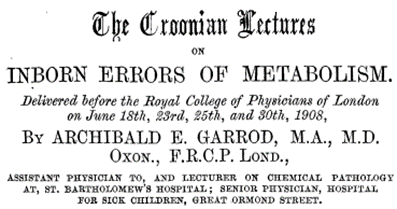Rare Disease Day: Celebrating progress and hope for the future
Rare Disease Day: Celebrating progress and hope for the future
Oren Cohen, MD, Chief Medical Officer and President, Clinical Pharmacology
February 29 is Rare Disease Day, fittingly on the rarest of days (leap year). It is a day to raise awareness about rare diseases, an area which is important to so many of our efforts in drug development. Although rare diseases are rare by definition, collectively there are more than 300 million people living with a rare disease in the world today[1]. These diseases disproportionately affect children (about 50% of rare disease patients are children)[2]. This has been recognized for more than a century, and below you can see a landmark publication by Dr. Archibald Garrod from St. Bart’s and the Great Ormond Street Hospital for Sick Children, published on July 4, 1908 in The Lancet.

Garrod’s lectures and article discussed albinism, alkaptonuria, cystinuria and pentosuria. Biochemical abnormalities that were associated with disease states and also had a familial component were discovered and catalogued for decades, adding to Garrod’s initial list. Following the discovery of DNA as the genetic material by Avery, MacLeod and McCarty in 1944, a new era of discovery ensued. Dr. Victor McKusick, at Johns Hopkins University, championed the genetic basis of heritable rare diseases, and foreshadowed the human genome project.
So much progress has been made in recent times. In the U.S., the Orphan Drug Act has stimulated tremendous growth in the discovery and development of treatments for rare and orphan diseases. Over time, treatment strategies have evolved from enzyme replacement to correcting genetic mutations. For example, the treatment of infants with Spinal Muscular Atrophy (SMA) has been completely revolutionized over the last seven years, with two splicing modifiers and one gene replacement therapy now approved. Prior to the approval of these treatments, SMA was highly fatal by age 2-3; however, these treatments are leading to dramatic increases in longevity and quality of life that are still being evaluated. Similar exciting advances are being made with diseases such as Transthyretin Amyloid Cardiomyopathy, Hemophilia A, Sickle Cell Disease and many others.
Last year, 50% of all new drug approvals by the U.S. Food and Drug Administration were for rare diseases[1]. And, with the acceleration of cell and gene therapies, we can expect continued breakthroughs that will dramatically improve survival and quality of life in diseases that currently have devastating consequences.
Rare Disease Day serves as a reminder of the progress made in understanding and treating rare diseases. From the past to the present, we've seen remarkable advancements and we're moving toward a future where no disease is too rare to be ignored. Let's keep supporting those affected and working toward a world where everyone, regardless of their condition, has access to life-changing treatments. Together, we can turn this day of awareness into a beacon of hope for millions around the globe.
Learn more about our Rare Diseases, Advanced Therapies and Pediatrics Team (RAPT) and how we support complex and novel clinical trials.
[1] Nguengang Wakap, S., Lambert, DM, Olry, A. et al. Estimating cumulative point prevalence of rare diseases: analysis of the Orphanet database. Eur J Hum Genet 28, 165-173 (2020). https:/doi.org/10.1038/s41431-019-0508-0
[2] Batshaw ML, Groft SC, Krischer JP. Research into rare diseases of childhood. JAMA. 2014 May 7;311 (17): 1729-30. doi: 10.1001/jama.2013.285873. PMID: 24794360; PMCID: PMC6441966.
[3] Garrod, AE. "The Croonian Lectures on Inborn Errors of Metabolism." The Lancet, vol. 172, no. 4427, 1908, pp. 1-7. ISSN 0140-6736. doi: 10.1016/S0140-6736(01)78432-6.
[4] FDA. “FDA Approves Many New Drugs in 2023 That Will Benefit Patients and Consumers.” FDA Voices, U.S. Food and Drug Administration, https://www.fda.gov/news-events/fda-voices/fda-approves-many-new-drugs-2023-will-benefit-patients-and-consumers#:~:text=More%20than%20half%20(28%20of,received%20an%20orphan%2Ddrug%20designation Accessed 20 February 2024.







